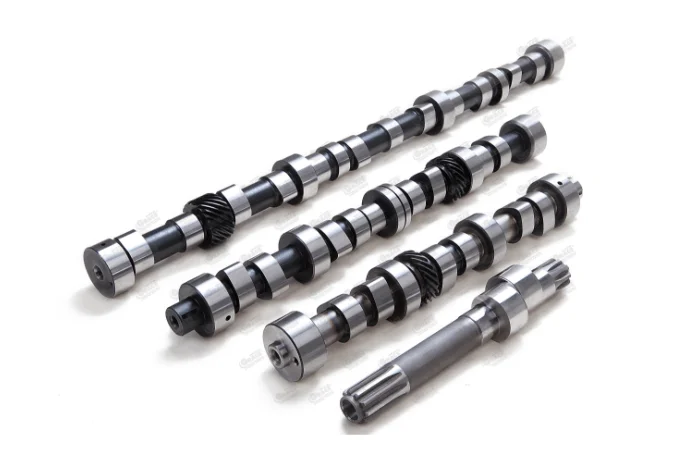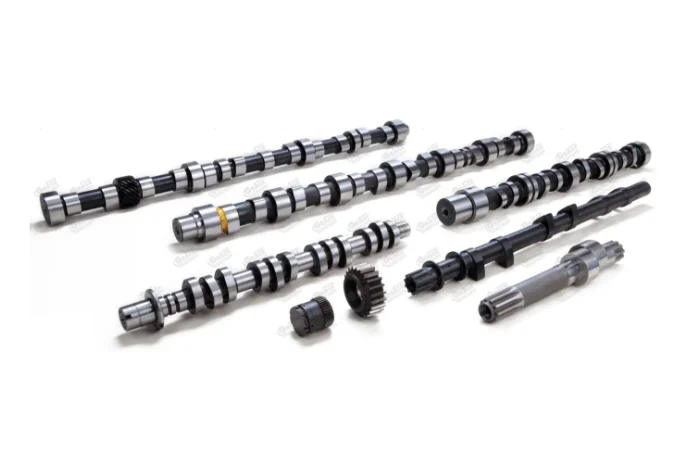Are you a distributor or importer?
-AND-OHV-(OVERHEAD-VALVE)-ENGINES-IN-INDIA.webp)


Perfect Timing – The Catalyst that Transforms Force into Work
Camshafts are the masters that control the timing of the complete engine assembly. Their lobes open and close the engine valves. In many engines they also actuate fuel injectors at just the precise moment to achieve maximum combustion efficiency. As such wear resistance and perfect geometry of the lobes and the journals are of prime importance.
Camshafts serve following functions in an IC engine:
Garima Global is only of the leading companies in India for engine camshafts. We specialize in developing custom made camshafts as per our customers’ requirements.
Size Range of Piston Rings in AutoGRACE® Brand
| SPECIFICATION | FROM | TO |
|---|---|---|
| Suitable for No. of Cylinders | 1 | 16 |
Garima Global supplies components for a wide variety of on-road, off-road, industrial and stationary applications such as: automotive (light duty) and light commercial, trucks (heavy duty), tractors (agricultural), earthmoving and construction machinery, generators, irrigation pumps, and defence / special purpose vehicles.
The brands for which we manufacture and export aftermarket products are Caterpillar, Chevrolet, Chrysler, Citroen, Cummins, Daewoo, DAF, Daihatsu, Detroit Diesel, Deutz, Fiat, Ford, Hino, Honda, Hyundai, International, Isuzu, Iveco, John Deere, Kamaz, Kia, Komatsu, Kubota, Land Rover, Leyland, Lister Petter, Lombardini, Mack, Mahindra, MAN, Massey Ferguson, Mazda, Mercedes Benz, Mitsubishi, Navistar, Nissan, Onan, Perkins, Peugeot, Renault, Scania, Suzuki, Tata, Tatra, Toyota, Ursus, UTB, Volvo, Yanmar and Zetor, amongst others.
Garima Global also export parts for air-brake compressors like Wabco, Bendix, Knorr, Cummins, Clayton Dewandre, Mercedes, Midland etc.
Garima Global has developed an extensive range of components for engine, braking, transmission, suspension, steering, chassis, electrical, lighting and other automotive sub-systems. To assist our customers with choosing the right product for their requirements we have published comprehensive catalogs with engine / vehicle models, interchange with references of OEMs and other popular aftermarket brands, fitment dimensions and other technical data. We strongly encourage you to contact us with your specific requirements so that we can email you the relevant catalogs, and we look forward to starting a mutually beneficial business relationship with you soon!
Camshaft design is influenced by the valve train configuration, engine structure, manufacturing processes and functional complexity.
The camshaft is located nearer to the crankshaft in the engine block and the lifting action is transferred from the camshaft to the valves through an assembly of tappets / cam followers, push rods and rocker arms. The trend is against this configuration due to lower stiffness of the engine system and more moving parts.
Two main variants of this configuration are Single Overhead Camshaft (SOHC) and Double Overhead Camshaft (DOHC) and in both, the camshaft is located in the cylinder head. Crankshaft powers the camshaft by a timing belt or chain at half its own rotational speed. In this configuration also many different types of assemblies consisting of tappets / cam followers, rocker arms and hydraulic lifters are used to actuate the valves.
Simpler and more primitive technology characterized by the cam lobe sliding on a tappet head, with both surfaces hardened, polished and sometimes crowned to reduce frictional losses and achieve gradual wear-in.
Modern engines lean toward the tappet being replaced by a cam follower in which its roller and the cam lobe come in to rolling contact. This reduces drive losses and increases tolerable loading, while improving tribologic characteristics of the interface, increasing life of the mating components.
Split cam bearing shells, similar to con rod big end bearings, are used at bearing races which form part of the camshaft.
Bearing races have a diameter bigger than the maximum lobe height so that the camshaft can be slid through the solid bearing races built into the block or head.
1% Chromium is alloyed in Grade 17 cast iron to create 5-7% free carbides, which is then hardened to 52-56 HRC in lobe area. This material can also be used in Chilled Cast Camshafts where rapid cooling of lobe area creates a matrix of carbide that is extremely scuff resistant.
Fiat used SG Iron in 1980s but the disadvantage is it scuffs easily in the bearing area. Can be hardened to 52-58 HRC.
EN8 and EN9 grades have good through-hardening characteristics and are especially compatible with roller cam followers after induction hardening of lobes.
EN351 and EN34 can be used with a chilled cast tappet after case hardening.
EN40B after nitriding gives similar hardness as a chilled cast camshaft but with superior strength of steel.
CHEMICAL COMPOSITION
| ELEMENT | EN8 SAE 1040 080M40 1.1186 |
EN9 SAE 1055 070M55 1.0535 |
EN351 635M15 |
EN34 665M17 |
EN40B 722M24 |
|---|---|---|---|---|---|
| Carbon (%) | 0.35-0.45 | 0.50-0.60 | 0.10-0.20 | 0.14-0.20 | 0.20-0.28 |
| Silicon (%) | 0.05-0.35 | 0.05-0.35 | 0.35 MAX | 0.10-0.35 | 0.10-0.35 |
| Manganese (%) | 0.60-1.00 | 0.50-0.80 | 0.60-1.00 | 0.35-0.75 | 0.45-0.70 |
| Phosphorus (%) | 0.060 MAX | 0.060 MAX | - | 0.035 MAX | 0.035 MAX |
| Sulphur (%) | 0.060 MAX | 0.060 MAX | - | 0.040 MAX | 0.040 MAX |
| Chromium (%) | - | - | 0.40-0.80 | - | 3.00-3.50 |
| Molybdenum (%) | - | - | 0.08-0.10 | 0.20-0.30 | 0.45-0.65 |
| Nickel (%) | - | - | 0.60-1.00 | 1.50-2.00 | - |
AutoGRACE® camshafts are manufactured by experienced OEM factories in a wide variety of materials to suit every kind of application.
Nodular (spheroidal graphite) or laminar graphite cast iron camshafts have the ideal tribologic characteristics for sliding and low-load rolling contact. The core area and the bearing journals may be grey cast iron with good machinability while the lobes are hardened by one of the following processes:
Rapidly alternating electrical current is used to heat the material in lobe area above its transformation temperature, and then it is rapidly cooled by quenching, causing a case of martensitic structure to develop on the surface which is extremely tough. The softer core remains unchanged, which makes for a very fatigue resistant component.
Lobe area is cooled rapidly during casting of the camshaft to create an outer ledeburite structure which is highly wear-resistant in chilled cast camshafts.
For smaller production runs this is the preferred process since upfront investment into forging moulds, setup etc. can be avoided, however, strength is many times a limiting factor in these camshafts.
Steel tube is rough forged and then machined. Cam lobes and bearing journals are then slid on to the tube and attached to the tube by shrink-fit, press fit, high-pressure forming or some such process. The lobes may be of steel, or sintered powder metal to achieve highly precise lobe geometry which eliminates the need for any further machining.
In high load and high speed applications that place great demand on torsional and/or tensile strength of the camshaft, forged steel camshafts are the preferred choice. Costly development of forging dies require high minimum quantities for production runs to be feasible.
To reduce the static mass as well as the rotational inertia of the system, various techniques are used to reduce the mass of the camshaft. Simplest of them is to drill a straight or graduated hole through the central axis of the camshaft which may also be used as part of the lubrication circuit. Integrating bearings into the camshaft core and reducing wall thickness of casting tube are also promising ways to reduce mass.
AutoGRACE® camshafts undergo stringent checks at our in-house lab before dispatch to our discerning customers globally on the following important parameters, among others:
Start the
conversation.
Every beautiful relationship starts with a simple hello. So let’s chat. It might just be the start of something memorable.